2003 CHEVROLET SILVERADO 4WD
[x] Cancel search: 4WDPage 122 of 556
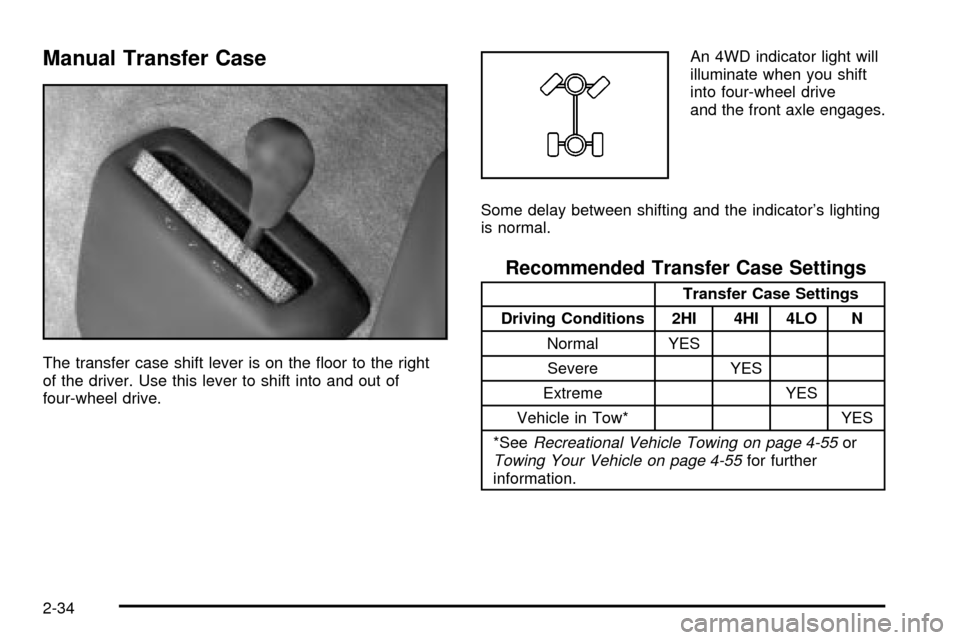
Manual Transfer Case
The transfer case shift lever is on the ¯oor to the right
of the driver. Use this lever to shift into and out of
four-wheel drive.An 4WD indicator light will
illuminate when you shift
into four-wheel drive
and the front axle engages.
Some delay between shifting and the indicator's lighting
is normal.
Recommended Transfer Case Settings
Transfer Case Settings
Driving Conditions 2HI 4HI 4LO N
Normal YES
Severe YES
Extreme YES
Vehicle in Tow* YES
*See
Recreational Vehicle Towing on page 4-55orTowing Your Vehicle on page 4-55for further
information.
2-34
Page 125 of 556
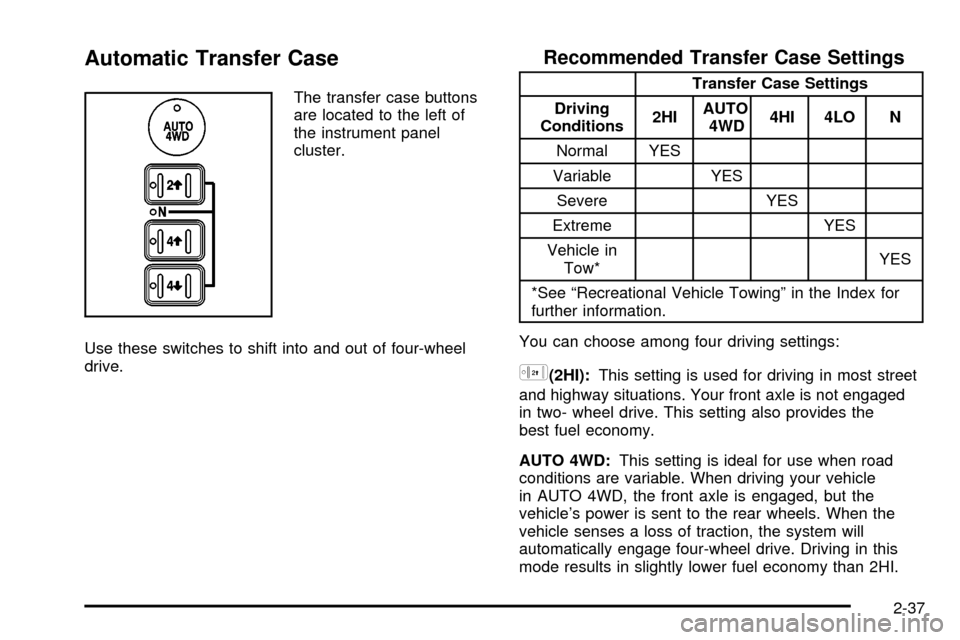
Automatic Transfer Case
The transfer case buttons
are located to the left of
the instrument panel
cluster.
Use these switches to shift into and out of four-wheel
drive.
Recommended Transfer Case Settings
Transfer Case Settings
Driving
Conditions2HIAUTO
4WD4HI 4LO N
Normal YES
Variable YES
Severe YES
Extreme YES
Vehicle in
Tow*YES
*See ªRecreational Vehicle Towingº in the Index for
further information.
You can choose among four driving settings:
h(2HI):This setting is used for driving in most street
and highway situations. Your front axle is not engaged
in two- wheel drive. This setting also provides the
best fuel economy.
AUTO 4WD:This setting is ideal for use when road
conditions are variable. When driving your vehicle
in AUTO 4WD, the front axle is engaged, but the
vehicle's power is sent to the rear wheels. When the
vehicle senses a loss of traction, the system will
automatically engage four-wheel drive. Driving in this
mode results in slightly lower fuel economy than 2HI.
2-37
Page 126 of 556
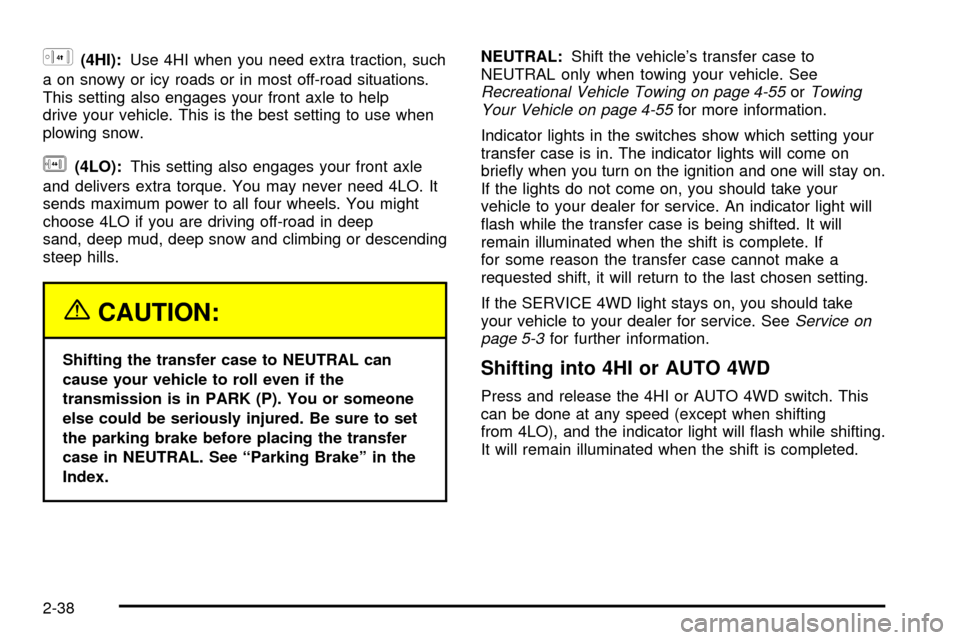
G(4HI):Use 4HI when you need extra traction, such
a on snowy or icy roads or in most off-road situations.
This setting also engages your front axle to help
drive your vehicle. This is the best setting to use when
plowing snow.
g(4LO):This setting also engages your front axle
and delivers extra torque. You may never need 4LO. It
sends maximum power to all four wheels. You might
choose 4LO if you are driving off-road in deep
sand, deep mud, deep snow and climbing or descending
steep hills.
{CAUTION:
Shifting the transfer case to NEUTRAL can
cause your vehicle to roll even if the
transmission is in PARK (P). You or someone
else could be seriously injured. Be sure to set
the parking brake before placing the transfer
case in NEUTRAL. See ªParking Brakeº in the
Index.NEUTRAL:Shift the vehicle's transfer case to
NEUTRAL only when towing your vehicle. See
Recreational Vehicle Towing on page 4-55orTowing
Your Vehicle on page 4-55for more information.
Indicator lights in the switches show which setting your
transfer case is in. The indicator lights will come on
brie¯y when you turn on the ignition and one will stay on.
If the lights do not come on, you should take your
vehicle to your dealer for service. An indicator light will
¯ash while the transfer case is being shifted. It will
remain illuminated when the shift is complete. If
for some reason the transfer case cannot make a
requested shift, it will return to the last chosen setting.
If the SERVICE 4WD light stays on, you should take
your vehicle to your dealer for service. See
Service on
page 5-3for further information.
Shifting into 4HI or AUTO 4WD
Press and release the 4HI or AUTO 4WD switch. This
can be done at any speed (except when shifting
from 4LO), and the indicator light will ¯ash while shifting.
It will remain illuminated when the shift is completed.
2-38
Page 127 of 556

Shifting into 2HI
Press and release the 2HI switch. This can be done at
any speed (except when shifting from 4LO).
Shifting into 4LO
To shift to 4LO, the ignition must be in RUN and the
vehicle must be stopped or moving less than 3 mph
(4.8 km/h) with the transmission in NEUTRAL (N). The
preferred method for shifting into 4LO is to have your
vehicle moving 1 to 2 mph (1.6 to 3.2 km/h). Press and
release the 4LO switch. You must wait for the 4LO
indicator light to stop ¯ashing and remain illuminated
before shifting your transmission in gear.
Notice:Shifting the transmission into gear before
the 4LO indicator light has stopped ¯ashing could
damage the transfer case. To help avoid damaging
your vehicle, always wait for the 4LO indicator light
to stop ¯ashing before shifting your transmission
into gear.
It is typical for your vehicle to exhibit signi®cant
engagement noise and bump when shifting between 4LO
and 4HI ranges or from NEUTRAL with the engine
running.
If the 4LO switch is pressed when your vehicle is in gear
and/or moving, the 4LO indicator light will ¯ash for
30 seconds and not complete the shift unless your
vehicle is moving less than 3 mph (4.8 km/h) and the
transmission is in NEUTRAL (N). After 30 seconds the
transfer case will return to the setting last chosen.
Shifting Out of 4LO
To shift from 4LO to 4HI, AUTO 4WD or 2HI your
vehicle must be stopped or moving less than 3 mph
(4.8 km/h) with the transmission in NEUTRAL (N) and
the ignition in RUN. The preferred method for shifting out
of 4LO is to have your vehicle moving 1 to 2 mph
(1.6 to 3.2 km/h). Press and release the 4HI, AUTO
4WD or 2HI switch. You must wait for the 4HI, AUTO
4WD or 2HI indicator light to stop ¯ashing and
remain illuminated before shifting your transmission
into gear.
Notice:Shifting the transmission into gear before
the 4LO indicator light has stopped ¯ashing
could damage the transfer case. To help avoid
damaging your vehicle, always wait for the 4LO
indicator light to stop ¯ashing before shifting your
transmission into gear.
It is typical for your vehicle to exhibit signi®cant
engagement noise and bump when shifting between
4LO and 4HI ranges or from NEUTRAL with the engine
running.
If the 4HI, AUTO 4WD or 2HI switch is pressed when
your vehicle is in gear and/or moving, the 4HI,
AUTO 4WD or 2HI indicator light will ¯ash for
30 seconds but will not complete the shift unless your
vehicle is moving less than 3 mph (4.8 km/h) and
the transmission is in NEUTRAL (N).
2-39
Page 128 of 556

Shifting into NEUTRAL
To shift the transfer case to NEUTRAL do the following:
1. Make sure the vehicle is parked so that it will
not roll.
2. Set the parking brake.
3. Start the vehicle or turn the ignition to RUN.
4. Connect the vehicle to the towing vehicle.
5. Put the transmission in NEUTRAL (N).
6. Shift the transfer case to 2HI.
7. Simultaneously press and hold the 2HI and 4LO
buttons for 10 seconds. The red NEUTRAL light
will come on when the transfer case shift to
NEUTRAL is complete.
8. Shift the transmission to REVERSE (R) for one
second, then shift the transmission to DRIVE (D)
for one second.
9. Turn the ignition to OFF.
10. Place the transmission shift lever in PARK (P).
11. Release the parking brake prior to towing.
Shifting Out of NEUTRAL
To shift out of NEUTRAL:
1. Set the parking brake and apply the regular brake
pedal.
2. Shift the transmission to NEUTRAL (N) and turn the
ignition to RUN with the engine off.
3. Press the button for the desired transfer case shift
position (2HI, 4HI, AUTO 4WD or 4LO).
4. After the transfer case has shifted out of NEUTRAL
the red light will go out.
5. Release the parking brake.
6. You may start the engine and shift the transmission
to the desired position.
Excessively shifting the transfer case into or out of the
different modes may cause the transfer case to
enter the shift protection mode. This will protect the
transfer case from possible damage and will only allow
the transfer case to respond to one shift per 10
seconds. The transfer case may stay in this mode for
up to three minutes.
2-40
Page 225 of 556
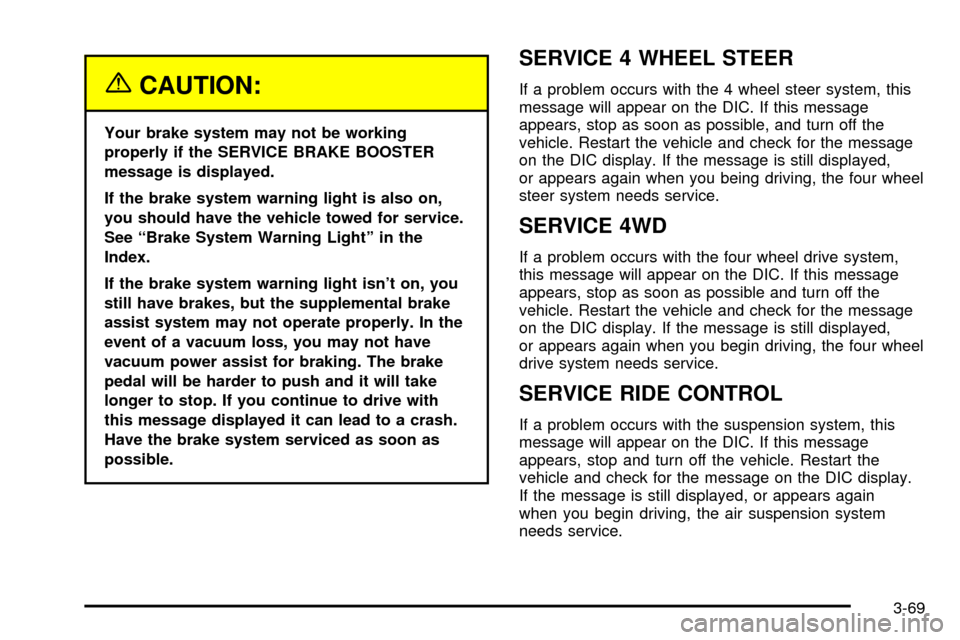
{CAUTION:
Your brake system may not be working
properly if the SERVICE BRAKE BOOSTER
message is displayed.
If the brake system warning light is also on,
you should have the vehicle towed for service.
See ªBrake System Warning Lightº in the
Index.
If the brake system warning light isn't on, you
still have brakes, but the supplemental brake
assist system may not operate properly. In the
event of a vacuum loss, you may not have
vacuum power assist for braking. The brake
pedal will be harder to push and it will take
longer to stop. If you continue to drive with
this message displayed it can lead to a crash.
Have the brake system serviced as soon as
possible.
SERVICE 4 WHEEL STEER
If a problem occurs with the 4 wheel steer system, this
message will appear on the DIC. If this message
appears, stop as soon as possible, and turn off the
vehicle. Restart the vehicle and check for the message
on the DIC display. If the message is still displayed,
or appears again when you being driving, the four wheel
steer system needs service.
SERVICE 4WD
If a problem occurs with the four wheel drive system,
this message will appear on the DIC. If this message
appears, stop as soon as possible and turn off the
vehicle. Restart the vehicle and check for the message
on the DIC display. If the message is still displayed,
or appears again when you begin driving, the four wheel
drive system needs service.
SERVICE RIDE CONTROL
If a problem occurs with the suspension system, this
message will appear on the DIC. If this message
appears, stop and turn off the vehicle. Restart the
vehicle and check for the message on the DIC display.
If the message is still displayed, or appears again
when you begin driving, the air suspension system
needs service.
3-69
Page 356 of 556
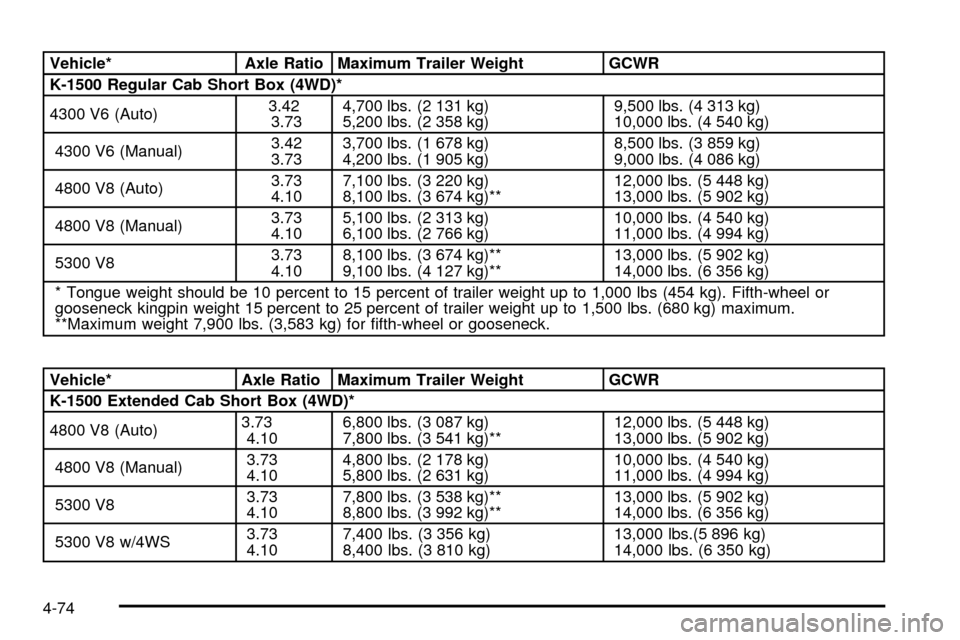
Vehicle* Axle Ratio Maximum Trailer Weight GCWR
K-1500 Regular Cab Short Box (4WD)*
4300 V6 (Auto)3.42
3.734,700 lbs. (2 131 kg)
5,200 lbs. (2 358 kg)9,500 lbs. (4 313 kg)
10,000 lbs. (4 540 kg)
4300 V6 (Manual)3.42
3.733,700 lbs. (1 678 kg)
4,200 lbs. (1 905 kg)8,500 lbs. (3 859 kg)
9,000 lbs. (4 086 kg)
4800 V8 (Auto)3.73
4.107,100 lbs. (3 220 kg)
8,100 lbs. (3 674 kg)**12,000 lbs. (5 448 kg)
13,000 lbs. (5 902 kg)
4800 V8 (Manual)3.73
4.105,100 lbs. (2 313 kg)
6,100 lbs. (2 766 kg)10,000 lbs. (4 540 kg)
11,000 lbs. (4 994 kg)
5300 V83.73
4.108,100 lbs. (3 674 kg)**
9,100 lbs. (4 127 kg)**13,000 lbs. (5 902 kg)
14,000 lbs. (6 356 kg)
* Tongue weight should be 10 percent to 15 percent of trailer weight up to 1,000 lbs (454 kg). Fifth-wheel or
gooseneck kingpin weight 15 percent to 25 percent of trailer weight up to 1,500 lbs. (680 kg) maximum.
**Maximum weight 7,900 lbs. (3,583 kg) for ®fth-wheel or gooseneck.
Vehicle* Axle Ratio Maximum Trailer Weight GCWR
K-1500 Extended Cab Short Box (4WD)*
4800 V8 (Auto)3.73
4.106,800 lbs. (3 087 kg)
7,800 lbs. (3 541 kg)**12,000 lbs. (5 448 kg)
13,000 lbs. (5 902 kg)
4800 V8 (Manual)3.73
4.104,800 lbs. (2 178 kg)
5,800 lbs. (2 631 kg)10,000 lbs. (4 540 kg)
11,000 lbs. (4 994 kg)
5300 V83.73
4.107,800 lbs. (3 538 kg)**
8,800 lbs. (3 992 kg)**13,000 lbs. (5 902 kg)
14,000 lbs. (6 356 kg)
5300 V8 w/4WS3.73
4.107,400 lbs. (3 356 kg)
8,400 lbs. (3 810 kg)13,000 lbs.(5 896 kg)
14,000 lbs. (6 350 kg)
4-74
Page 357 of 556
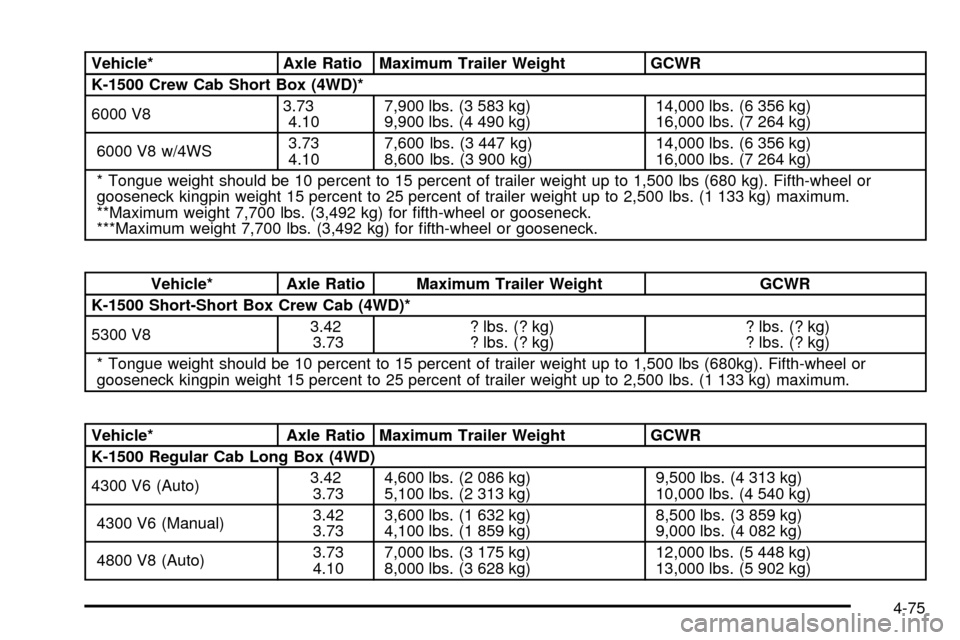
Vehicle* Axle Ratio Maximum Trailer Weight GCWR
K-1500 Crew Cab Short Box (4WD)*
6000 V83.73
4.107,900 lbs. (3 583 kg)
9,900 lbs. (4 490 kg)14,000 lbs. (6 356 kg)
16,000 lbs. (7 264 kg)
6000 V8 w/4WS3.73
4.107,600 lbs. (3 447 kg)
8,600 lbs. (3 900 kg)14,000 lbs. (6 356 kg)
16,000 lbs. (7 264 kg)
* Tongue weight should be 10 percent to 15 percent of trailer weight up to 1,500 lbs (680 kg). Fifth-wheel or
gooseneck kingpin weight 15 percent to 25 percent of trailer weight up to 2,500 lbs. (1 133 kg) maximum.
**Maximum weight 7,700 lbs. (3,492 kg) for ®fth-wheel or gooseneck.
***Maximum weight 7,700 lbs. (3,492 kg) for ®fth-wheel or gooseneck.
Vehicle* Axle Ratio Maximum Trailer Weight GCWR
K-1500 Short-Short Box Crew Cab (4WD)*
5300 V83.42
3.73? lbs. (? kg)
? lbs. (? kg)? lbs. (? kg)
? lbs. (? kg)
* Tongue weight should be 10 percent to 15 percent of trailer weight up to 1,500 lbs (680kg). Fifth-wheel or
gooseneck kingpin weight 15 percent to 25 percent of trailer weight up to 2,500 lbs. (1 133 kg) maximum.
Vehicle* Axle Ratio Maximum Trailer Weight GCWR
K-1500 Regular Cab Long Box (4WD)
4300 V6 (Auto)3.42
3.734,600 lbs. (2 086 kg)
5,100 lbs. (2 313 kg)9,500 lbs. (4 313 kg)
10,000 lbs. (4 540 kg)
4300 V6 (Manual)3.42
3.733,600 lbs. (1 632 kg)
4,100 lbs. (1 859 kg)8,500 lbs. (3 859 kg)
9,000 lbs. (4 082 kg)
4800 V8 (Auto)3.73
4.107,000 lbs. (3 175 kg)
8,000 lbs. (3 628 kg)12,000 lbs. (5 448 kg)
13,000 lbs. (5 902 kg)
4-75